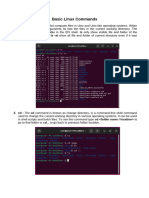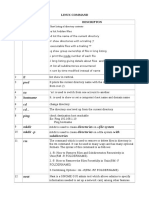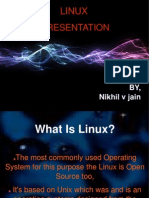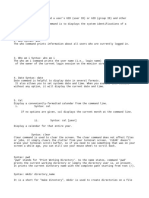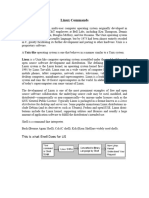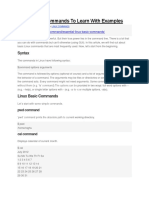0 ratings0% found this document useful (0 votes)
70 viewsBasic Commands in Linux
This document lists and describes common Linux commands for viewing system information, navigating directories, manipulating files and folders, editing text, and managing processes. Some key commands include date to display the date and time, ls to list files, cd to change directories, cat to output the contents of files, and man to view command documentation. Larger commands like find locate files based on criteria, history keeps track of previously used commands, and shutdown safely powers down the system.
Uploaded by
AlwinCopyright
© © All Rights Reserved
Available Formats
Download as PDF, TXT or read online on Scribd
0 ratings0% found this document useful (0 votes)
70 viewsBasic Commands in Linux
This document lists and describes common Linux commands for viewing system information, navigating directories, manipulating files and folders, editing text, and managing processes. Some key commands include date to display the date and time, ls to list files, cd to change directories, cat to output the contents of files, and man to view command documentation. Larger commands like find locate files based on criteria, history keeps track of previously used commands, and shutdown safely powers down the system.
Uploaded by
AlwinCopyright
© © All Rights Reserved
Available Formats
Download as PDF, TXT or read online on Scribd
You are on page 1/ 2
Basic Commands in Linux
1. date : Display the current date and time in Linux.
2. cal : Shows current month calendar as output.
3. pwd: Displays the current directory. The current directory is nothing but the
directory in which you are currently operating.
4. whoami: command used to identify the current logged in user.
5. clear : clear the terminal
6. ls: command to list computer files.
7. mkdir: Command allows the user to create directories.
8. cd : command used to change the current working directory.
9. touch : Create an empty file.
10. nano: It is a text editor. Nano text editor is used to create and edit files, included in
most Linux distributions.
11. vi: vi is one of the most commonly used editor program and included by default
with every UNIX and linux system.
12. vim: It is a text editor. Vim is an improved version of the vi editor.
13. cat: It prints the content of a file.
14. head: By default, without any option, the head command will display the first 10
lines from the file.
15. tail: By default, it displays the last ten lines of a file.
16. wc: wc stands for word count. It is used to find out number of lines, word count,
byte and characters count in the files specified in the file arguments.
17. man: It provides a detailed view of the command which includes NAME, SYNOPSIS,
DESCRIPTION, OPTIONS, EXIT STATUS, RETURN VALUES, ERRORS, FILES, VERSIONS,
EXAMPLES and AUTHORS.
18. pinfo: Pinfo is an info file viewer or a script for viewing info files.
19. find: find is a command-line utility that locates files based on some user-specified
criteria.
20. history: history command in Linux is a utility with the purpose of keeping track of
previously used commands in the command line.
21. cp: The cp command has a simple purpose to copy files and folders from one place
to another.
22. mv: mv stands for move and is essentially used for moving files or directories from
one location to another.
23. rm: The rm command is used to remove files and directories in Linux.
24. reboot: reboot command is used restart or reboot the system.
25. shutdown: The shutdown command in Linux is used to power down the system in a
safe way.
You might also like
- 2) Linux Configuration and Basic CommandsNo ratings yet2) Linux Configuration and Basic Commands7 pages
- Ls Is A Linux Shell Command That Lists Directory Contents of Files and DirectoriesNo ratings yetLs Is A Linux Shell Command That Lists Directory Contents of Files and Directories22 pages
- Session-1: 50 Most Useful Linux Commands: Category-1: File System ManagementNo ratings yetSession-1: 50 Most Useful Linux Commands: Category-1: File System Management6 pages
- Basic50linuscommand 100602035730 Phpapp02No ratings yetBasic50linuscommand 100602035730 Phpapp0211 pages
- 38 Basic Linux Commands To Learn With Examples: SyntaxNo ratings yet38 Basic Linux Commands To Learn With Examples: Syntax18 pages





